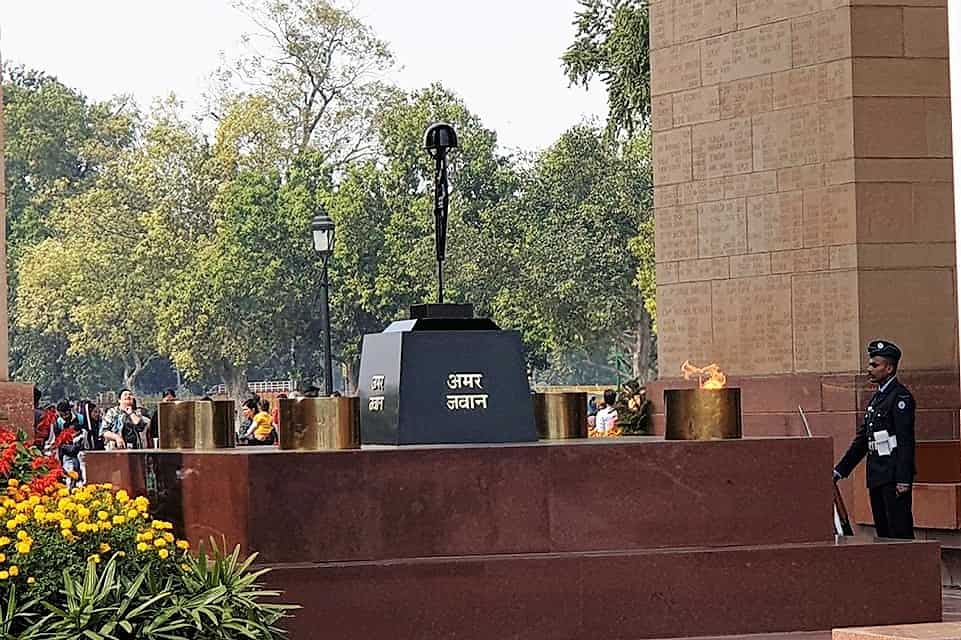After having lived in Delhi through the seventies for over a decade, every short trip I make to Delhi is one of a sense of loss. I do not recognize the Delhi that I grew up in anymore. With the exploding boundaries, the flyovers that dwarf the city, the mindboggling traffic and the crowds, and of course the smog, the pollution, I have stopped relating to the city that I loved so much.
As I made a brief two-day visit to the city, I decided to recapture the magic, the stunning royal walk from India Gate to Rashtrapati Bhavan. Much to my dismay, India Gate was cordoned off up to a 100 metres. The huge tourist crowd and the era that we live in, probably justifies these security precautions. I tried to read the names of a few soldiers in vain and thought back about the time my sisters and I would read, as many names as we could, as we walked around the memorial and under the archway with no restrictions in the 70s.
The inscription on this World War I memorial to the soldiers in British Indian army, 77000 of them, says, ‘to the dead of the Indian army who fell and are honoured in France, Flanders, Mesopotamia, Persia, East Africa, Gallipoli and elsewhere in the Near and the Far East, and in sacred memory of those whose names are here’
The 2-km walk towards Rashtrapati Bhavan was less enchanting as I walked in the lawns that had been sullied in the wake of the Republic Day celebrations, a make shift exhibition propagating Swachh Bharat, unmindful of all the litter around, screeching and honking vehicles, street vendors and the new age service providers who literally drag you to pose in front of the memorial to get you that ultimate photograph in the capital city. Suffice it to say I was losing some of my enthusiasm.
The Rashtrapati Bhavan itself looked hazy in the Delhi smog. However, I do believe that inspite of my memories of a mesmerizing past, India Gate and Rashtrapati Bhavan are still awe inspiring, if only you can shut out the sounds and people around you. This boulevard is the place where India celebrates becoming a republic by parading its military might and celebrating its people on January 26th every year.
And then, thanks to my daughter, I went to a place that I knew nothing about.
Sunder Nursery, most certainly does not conjure up a vision of any architectural or period interest. However, It is a 16th century heritage park, built by the Mughals and was known as Azim Bagh. It covers an area of 90 acres and till recently was just a nursery for plants. The nursery had been established for experimental plants during the British period and being near Sunder tomb it acquired this rather insipid moniker, Sunder Nursery.
Today, this magnificent park houses 15 heritage monuments, out of which six are UNESCO declared sites. The Aga Khan Trust, along with the Archaeological Survey of India has painstakingly restored most of these monuments and the Mughal Gardens have been recreated, including an ornamental central vista.
Mughal era inspired gardens, lotus shaped fountains, a stunning amphitheater, waterbodies, sunken garden, butterfly park, sand stone pathways are all part of the huge space. The bagh boasts of 300 species of trees and is home to over 80 species of birds. Time magazine lists this as one of the 100 places to visit in the world , “a horticultural haven with restored Mughal era monuments and water features”.
The ambitious restoration project, in progress still, is all set to make it one of the largest in the world with a mapped area of 900 acres. I do so hope that they would revert it to the original name of ‘Azim Bagh’.
The remnants of Mughal architecture scattered all around Delhi gives it such a unique character. The spring in Delhi makes it enchanting, the food is so delicious. The memories of our boat ride on Yamuna, chow mein in the Tibetan monastery, the lively university campus, the picnics in the bewitching Lodi Gardens, the ‘Son et lumiere’ in Red Fort, the rickshaw ride on Chandni Chowk, witnessing the majestic ‘Beating the Retreat’, in front of Rashtrapati Bhavan, the samosa stall near Plaza cinema, the library in Shankar market with a treasure trove of P.G.Wodehouse, the cosy patch of vegetable garden at home with phool gobi (cauliflower) and bandh gobi (cabbage), the roasted corn on the cob in every street corner — all these memories come back in bits and pieces, recreating Delhi in the mind, replete in all its lost glory.
And so I shut out the pollution and the noise to rebuild my ties with this city.
[This article is an edited version of the author’s original post on a social media channel, and has been republished with permission.]
